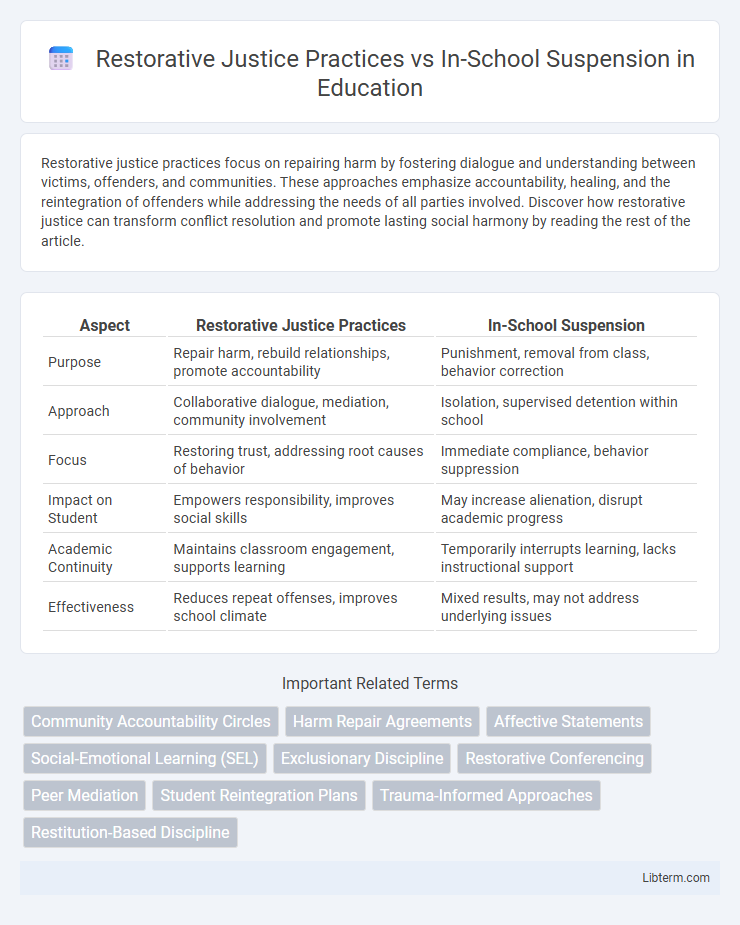Restorative justice practices focus on repairing harm by fostering dialogue and understanding between victims, offenders, and communities. These approaches emphasize accountability, healing, and the reintegration of offenders while addressing the needs of all parties involved. Discover how restorative justice can transform conflict resolution and promote lasting social harmony by reading the rest of the article.
Table of Comparison
| Aspect | Restorative Justice Practices | In-School Suspension |
|---|---|---|
| Purpose | Repair harm, rebuild relationships, promote accountability | Punishment, removal from class, behavior correction |
| Approach | Collaborative dialogue, mediation, community involvement | Isolation, supervised detention within school |
| Focus | Restoring trust, addressing root causes of behavior | Immediate compliance, behavior suppression |
| Impact on Student | Empowers responsibility, improves social skills | May increase alienation, disrupt academic progress |
| Academic Continuity | Maintains classroom engagement, supports learning | Temporarily interrupts learning, lacks instructional support |
| Effectiveness | Reduces repeat offenses, improves school climate | Mixed results, may not address underlying issues |
Understanding Restorative Justice Practices
Restorative Justice Practices emphasize repairing harm through dialogue and mutual agreement, fostering accountability and empathy among students involved in conflicts. This approach contrasts with In-School Suspension, which primarily removes students from the learning environment without addressing underlying behavioral issues. Research shows that Restorative Justice leads to reduced recidivism, improved school climate, and increased student engagement compared to traditional disciplinary methods.
What Is In-School Suspension?
In-school suspension (ISS) is a disciplinary method used in schools where students are removed from their regular classroom environment but remain within the school premises for a set period. During ISS, students complete assigned academic work under supervision, isolated from their peers to minimize disruption while addressing behavioral issues. Unlike restorative justice practices that emphasize repairing harm and dialogue, ISS primarily serves as a punitive measure focused on maintaining school discipline and order.
Key Differences Between Restorative Justice and Suspension
Restorative justice practices prioritize repairing harm through dialogue and accountability, fostering a supportive school environment to address the root causes of student behavior. In contrast, in-school suspension isolates students from the classroom without addressing underlying issues, often leading to disengagement and higher recidivism rates. Studies show restorative justice reduces repeat offenses and improves student relationships, whereas suspension is linked to increased dropout rates and negative academic outcomes.
Benefits of Restorative Justice in Schools
Restorative justice practices in schools promote accountability by encouraging students to understand the impact of their actions and actively participate in repairing harm, leading to improved relationships and reduced repeat offenses. These practices foster a supportive learning environment that enhances student engagement, emotional well-being, and social skills, contrasting with the isolation often experienced in in-school suspension. Research shows that restorative approaches decrease disciplinary referrals and suspensions, contributing to higher attendance rates and overall academic success.
Limitations of In-School Suspension
In-school suspension often fails to address the root causes of student behavior and can contribute to increased dropout rates, as students miss valuable instructional time. This punitive approach may lead to disengagement and does not provide opportunities for meaningful reflection or conflict resolution. Compared to restorative justice practices, in-school suspension lacks strategies for repairing harm and fostering positive relationships within the school community.
Impact on Student Behavior and Learning
Restorative justice practices promote positive student behavior and deeper learning by encouraging accountability and fostering empathy, resulting in lower recidivism rates compared to in-school suspension (ISS). ISS often leads to missed instructional time and increased disengagement, which can negatively impact academic performance and exacerbate behavioral issues. Studies indicate that schools implementing restorative justice see improved attendance, reduced disciplinary referrals, and enhanced student-teacher relationships, contributing to a more supportive learning environment.
Addressing Racial and Disciplinary Disparities
Restorative justice practices emphasize repairing harm and fostering accountability, effectively reducing racial and disciplinary disparities by promoting inclusive dialogue and understanding among students. In-school suspension often exacerbates these disparities by disproportionately targeting students of color, contributing to academic disengagement and increased dropout rates. Implementing restorative approaches in schools creates equitable disciplinary environments that support positive behavioral outcomes and equitable treatment across diverse student populations.
Case Studies: Success Stories and Challenges
Case studies on restorative justice practices in schools reveal significant reductions in repeat disciplinary incidents and improved student-teacher relationships compared to traditional in-school suspension. Research highlights schools implementing restorative circles report up to 40% fewer behavioral referrals, indicating enhanced conflict resolution and accountability among students. However, challenges remain, including inconsistent staff training and resource allocation, which can hinder the full effectiveness of restorative approaches versus the more standardized but punitive in-school suspension methods.
Implementing Restorative Justice in School Settings
Implementing restorative justice in school settings involves creating structured dialogue sessions that encourage accountability, empathy, and conflict resolution among students and staff. These practices promote repairing harm and building relationships rather than merely punishing misbehavior, leading to improved school climate and reduced recidivism. Evidence shows restorative justice decreases reliance on in-school suspension, boosting student engagement and overall academic outcomes.
Moving Toward Inclusive Discipline Policies
Restorative justice practices offer an inclusive alternative to traditional in-school suspension by emphasizing accountability, empathy, and community healing rather than exclusion and punishment. These practices reduce recidivism rates and improve student relationships by fostering dialogue and mutual understanding, which supports positive behavioral change. Schools adopting restorative justice policies report lower suspension rates and higher overall student engagement, promoting equity and reducing disciplinary disparities.
Restorative Justice Practices Infographic

 libterm.com
libterm.com